Inhabit’s spring newsletter is all about experiencing the best of Portland from the comfort of your home. You’ll find it here!
Category: Local Info
Ways to Support Our Black Community
Silence is Violence. That statement on a protester’s sign really hit home. By sitting on the sidelines and not voicing our collective outrage, we are perpetuating racism. Our greatest tool is our voices — not quietly commiserating, while keeping our mouths shut. We have the power to vote for the right leaders, raise children that celebrate differences, hire the right people and support our community’s Black and minority run businesses (to name just a few).
I have compiled some of the many resources shared with me. Here are a few of the things we can do right now in our fight for social justice-
- Educate yourself on what challenges our Black family members face on a daily basis. Here are a few resources worth exploring:
- Personal and Professional Resources For Anti-Racism Work
- Who Gets to Be Afraid in America?
- So You Want to Talk About Race
- Resources for Talking about Race, Racism and Racialized Violence with Kids
- Trigger Warning
- The New Jim Crow: Mass Incarceration in the Age of Colorblindness
- White Fragility: Why It’s So Hard for White People to Talk About Racism
- A Parent’s Guide to Preventing and Responding to Prejudice
- Sign a Petition (DontShootPDX.org has also put together a list of other petitions and useful resources):
The Color of Change petition that asks Minneapolis Mayor Jacob Frey to block the involved police officers in the George Floyd case from receiving their pensions and from becoming police officers again. You can also text “Floyd” to the number 55156.
- Donate to organizations like your local Black Lives Matter chapter. Other great organizations are:
- National Council for Incarcerated and Formerly Incarcerated Women and Girls
- Color of Change
- The Sentencing Project
- National Association for the Advancement of Colored People (NAACP)
- Dream Defenders
- Support Black and minority run local businesses:
Race and racism is a reality that so many of us grow up learning to just deal with. But if we ever hope to move past it, it can’t just be on people of color to deal with it. It’s up to all of us — Black, white, everyone — no matter how well-meaning we think we might be, to do the honest, uncomfortable work of rooting it out.
– Michelle Obama
Something to Look Forward to this Summer in PDX
This is a blog post I have looked forward to writing! It’s all about simple pleasures these days. Sauvie Island, for most Portlanders, evokes a special feeling. It’s a short 10 miles from downtown, but crossing the Sauvie Island bridge and seeing sprawling farmland crowned by the four cascade mountain view (yes, on clear days you can see the top of Mt. Rainier too)–makes you exhale immediately. For some it’s biking, beach combing, fishing, kayaking or hiking, but the collective draw is the farms. Picking berries, stone fruit and flowers, hayrides, summer concerts, sipping wine and beer while dining on food cart delicacies and leaving with food grown by hardworking local farmers. Summer isn’t complete in Portland without a day on Sauvie Island.
This year I had the ultimate pleasure of helping very dear friends of mine realize their dream of owning a farm on Sauvie Island. It was a complicated and emotional transaction for all, but the end result was relieved and happy clients! Kruger’s Farm is now owned by an amazing local Sauvie Island family and has been renamed Topaz Farm. Kat and Jim are two of the smartest, hardworking people I know and their vision for the farm is going to blow your mind. Think farm-to-plate brunches and dinners, sipping wine, beer, local coffee or strawberry rhubarb lemonade while shopping in the farm store that features their own produce, as well as other Sauvie Island and local products. They have in-house chefs that create pasta, kale chips, pastries, pies, sandwiches, otter pops, etc., for the farm store using their produce. They use organic farming practices and plan to be an educational farm. They’ve partnered with the Sauvie Island Center to create camp and field trip opportunities for our schools. They are creating a bee wheel garden (the first of its kind on the west coast) and have all kinds of plans for future enrichment programs. They’ve accomplished all this just since they purchased the farm in January. Can you imagine what the future holds?!!
Of course COVID-19 has changed a few things, but visiting a farm and getting outside isn’t one of them. Don’t we all need a change of scenery! There are some things that are on hold right now and Topaz Farm is following a very strict COVID-19 policy to keep their customers and employees safe. Follow them on Instagram or Facebook to stay up-to-date on berry picking calendars, farm-to-plate dinners and possibly a creative summer concert series.
When you visit Topaz Farm you will likely meet the whole family. Their daughters Maggie and Odessa work right alongside of their parents. Kat’s brother, Peter is working tirelessly to build all sorts of new farm features (clever mobile farm store displays, new pens for the animals, etc). I know they will be pleased to make your acquaintance (tell ‘em we sent ya!)
My wife and I had the pleasure of visiting the farm on opening day, May 27th. Enjoy some of the photos from our visit.








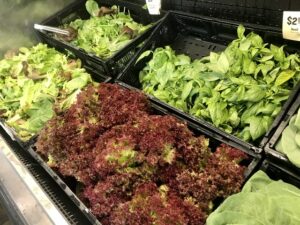




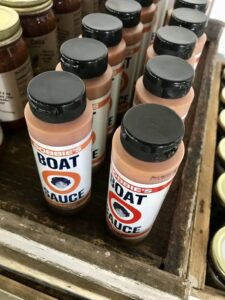


Adventures in DIY Gardening
Every spring, most of us find ourselves taking on projects as we come out of hibernation. This spring, while a bit different, is allowing us more time at home to clean our closets, organize, train for a marathon, or…go a bit crazy in the yard. Let me take a moment to say that Portland has some of the finest gardens in the world. One of my friends from Seattle even called our city’s favorite pastime “competitive gardening”. Personally, I have a list of outside projects to keep the family busy for a long time. In order to re-motivate myself and hopefully inspire others, I am going to share my backyard story from last spring. Keep in mind that each paragraph below is a weekend or 2 of actual labor with 2-4 workers.

On a fine April morning in 2019, I decided to take my coffee outside and hang out in the backyard. To my horror, the months of showers brought a jungle of waist high weeds, growing out of what I had thought to be a mulchy, forest floor under a Doug Fir. One of the reasons my significant other and I had purchased the house was to have awesome outdoor space, and we knew it was going to take some time and effort. Here was our first big project! My sweetie took a quick look at the mess and decided to fast track the project (he’s a bit meticulous and likes to keep very busy). We had been discussing a Japanese garden for months, so he sketched out a design on our son’s graph paper, and I called my parents to let them know we could use their help (they are the true green thumbs. I am a rookie).
Our first stop was The Home Depot, to find something to outline our path through the garden and keep the rocks we would be bringing in out of the mulch. We chose black plastic edging, about 4.5 inches in height. A 60-foot roll of this is about $30, and we would need 3-4 of them. There were other attractive options, but this was the right price. Digging mini trenches for the edging was a bit of a workout. We found that dragging a hammer in the dirt helped “bulldoze” a bit of a path in which we could then partially bury the edging. We also grabbed a few rolls of weed barrier fabric to lay down on the path where the gravel would eventually be. This was a very good move. I cannot imagine how much more we would have to weed if we had not done so.

 Now it was time for some of the planting fun! We chose a few beauties to be focal points in the garden, including a Japanese maple, weeping blue cedar, bonsai and a pink hydrangea and rhododendron. Additionally, we planted a handful of ferns and grasses in groups of 3. We are fans of not over planting and giving everything room to grow. These were purchased from multiple Eastside businesses including Portland Nursery, and Tony’s Garden Center. After a bit of deliberation on where to place the plants, the digging commenced.
Now it was time for some of the planting fun! We chose a few beauties to be focal points in the garden, including a Japanese maple, weeping blue cedar, bonsai and a pink hydrangea and rhododendron. Additionally, we planted a handful of ferns and grasses in groups of 3. We are fans of not over planting and giving everything room to grow. These were purchased from multiple Eastside businesses including Portland Nursery, and Tony’s Garden Center. After a bit of deliberation on where to place the plants, the digging commenced.
 With the plants in place, it was time to purchase mulch and rock. Lucky for us, fabulous Mount Scott Fuel is right up the street. If you have access to a pick-up truck you can avoid paying for delivery. They will load the product right into the bed of your truck, saving you quite a bit of money. We did this and found it easy to shovel out of our truck directly into the wheelbarrow that we borrowed from our awesome neighbor. Ultimately, we bought 3 yards of mulch, and had to make multiple trips to do so. (Caution-Do not overload your vehicle. Check weight limits)! Prices range from $32-45/yard if you pick up, and $100-130 if delivered. The following weekend was a similar routine, this time to purchase 2 yards of river rock. There are many different types of rock here, and you can check out samples in the office, and go into their yard to look at the big piles and get a different perspective. We opted for what I would call medium sized for ¼-¾ inch river rock to minimize gravel being tracked into the house. Our choice was very reasonably priced at $40/yard. Delivery would have been $115 for one yard, with discounts for 2 plus yards. Hauling the rock to the backyard was a bit more strenuous than moving the mulch, so it was helpful to have our strong 14-year old son around.
With the plants in place, it was time to purchase mulch and rock. Lucky for us, fabulous Mount Scott Fuel is right up the street. If you have access to a pick-up truck you can avoid paying for delivery. They will load the product right into the bed of your truck, saving you quite a bit of money. We did this and found it easy to shovel out of our truck directly into the wheelbarrow that we borrowed from our awesome neighbor. Ultimately, we bought 3 yards of mulch, and had to make multiple trips to do so. (Caution-Do not overload your vehicle. Check weight limits)! Prices range from $32-45/yard if you pick up, and $100-130 if delivered. The following weekend was a similar routine, this time to purchase 2 yards of river rock. There are many different types of rock here, and you can check out samples in the office, and go into their yard to look at the big piles and get a different perspective. We opted for what I would call medium sized for ¼-¾ inch river rock to minimize gravel being tracked into the house. Our choice was very reasonably priced at $40/yard. Delivery would have been $115 for one yard, with discounts for 2 plus yards. Hauling the rock to the backyard was a bit more strenuous than moving the mulch, so it was helpful to have our strong 14-year old son around.
 One of our final tasks on the project was to produce our own concrete circles in the path. My partner had a bit of experience working with concrete from his previous house, and he was excited to put his cement mixer to use again. To create the large circles, he constructed molds out of fiberboard and we placed them in the empty path. Then the concrete was mixed and poured in multiple batches. We made the small circles off to the side and simply placed them in the path after they were dry, and then finished filling in the river rock.
One of our final tasks on the project was to produce our own concrete circles in the path. My partner had a bit of experience working with concrete from his previous house, and he was excited to put his cement mixer to use again. To create the large circles, he constructed molds out of fiberboard and we placed them in the empty path. Then the concrete was mixed and poured in multiple batches. We made the small circles off to the side and simply placed them in the path after they were dry, and then finished filling in the river rock.
We spent a lot of time outside last year, and with spring’s arrival we are planning this year’s project: raised beds and vegetables, perfect for homeschooling and saving money on groceries!
COVID-19 Update from Inhabit’s Owner
March 31, 2020
The coronavirus is impacting everyone and every business in some way and the real estate industry is no exception. In many ways we are lucky because our shift to doing things virtually isn’t as big a leap as some businesses are facing. As a matter of fact, for many years we’ve been able to handle most of the home buying and selling transactions electronically. During the COVID-19 pandemic, Inhabit is committed to keeping the health and safety of our clients and agents at the forefront of everything we do. Even before Governor Brown initiated Oregon’s shelter-in-place order, Inhabit launched our Couch Concierge service that brings the entire home buying and selling process to our clients. Everything from virtual open houses, live video showings with our agents, to virtual contracts and closings.


Our listing clients shouldn’t worry about canceled open houses. We will create a digital marketing campaign that brings your house to potential buyers all without risking anyone’s health or safety. Our agents will tailor a showing plan that you feel the most comfortable with.
For our buyers, we are hosting live video tours. Our agents will walk you through the property showing you every nook and cranny with honest feedback on quality or construction issues they see.
 In-person tours are still an option in many cases when necessary, but with precautions we take very seriously. We recommend live video tours for anyone that has cold or flu symptoms or concerned about a possible COVID-19 exposure. This goes for clients, as well as, agents. Our agents are following the recommended 6 ft of social distancing and strict hand-washing and disinfecting policies. Our agents provide our COVID-19 Safe Showing policies to clients for review prior to visiting any property in-person so you can make the best decision for your health and safety.
In-person tours are still an option in many cases when necessary, but with precautions we take very seriously. We recommend live video tours for anyone that has cold or flu symptoms or concerned about a possible COVID-19 exposure. This goes for clients, as well as, agents. Our agents are following the recommended 6 ft of social distancing and strict hand-washing and disinfecting policies. Our agents provide our COVID-19 Safe Showing policies to clients for review prior to visiting any property in-person so you can make the best decision for your health and safety.
 We are a small business that puts the care of our clients and agents first. I started this company six years ago because I knew there was a better, more innovative way to serve clients. This is an industry that one-size definitely does not fit all. Inhabit has always been forward-looking and our size allows us to be nimble in creating services that address changing needs and goals. We are here to give you the best real estate advice possible, now and into the future.
We are a small business that puts the care of our clients and agents first. I started this company six years ago because I knew there was a better, more innovative way to serve clients. This is an industry that one-size definitely does not fit all. Inhabit has always been forward-looking and our size allows us to be nimble in creating services that address changing needs and goals. We are here to give you the best real estate advice possible, now and into the future.
Yours in health and prosperity!
Eric
2020 PDX Real Estate Outlook from Inhabit’s Owner Eric Hagstette
Settle in as Eric Pulls Back the Curtain on 2020 Portland Real Estate
 And just like that, it’s February 2020. If someone asked you when you were a kid what you thought 2020 would look like, did you picture this? I visualized space travel, robots, flying cars, lasers and futuristic stuff…not this everyday adulty life gig.
And just like that, it’s February 2020. If someone asked you when you were a kid what you thought 2020 would look like, did you picture this? I visualized space travel, robots, flying cars, lasers and futuristic stuff…not this everyday adulty life gig.
So where the heck did January go? To be honest, the reason my annual market outlook is so delayed is because this January was super busy for the Portland market. Now that I think about it, we were even selling houses right through the holidays as well. Portland may be experiencing growing pains, but the real estate market is alive and flourishing.
Last Year’s Prediction: Nailed it!
A year ago, I was calling for our buyers and investor clients to get into the market. It was a year of opportunity for our buyer clients after many years of seller-favored, tight inventory conditions. For the first time in a long while, buyers enjoyed shopping the market without urgency & pressure, having more than one house to choose from, price drops, seller incentives, and contingent offers. How sweet it was! Instead of calling it a buyer’s market or a seller’s market, we called it a “broker’s market” as we could make both sides happy by creating win/win transactions for our clients. We could place our buyers in homes without real estate “whiplash” and our sellers were walking away from the closing table with a smile on their face excited to move on in the market. It was a unique time. Everyone was pretty happy. I hope that you or someone you know took advantage of it.
2020 Current Conditions
The Portland market has always been nimble and this year is no exception. It changed quickly! Midway through Q4 of 2019, Portland inventory started to dwindle down. Furthermore, most sellers don’t list during the winter and holiday months, so market inventory continued to fall. Despite the BRUTAL Portland weather this winter, the buyers came out of the holidays with a big appetite and gobbled up what was left on the market. The close in Portland neighborhoods currently sit at 1.3 months of housing inventory (in the 450k-700k range). So the 2020 cycle begins with a fiery combination of low housing inventory, great interest rates, a seemingly healthy economy (with many new jobs coming to Portland) and a rapid erosion of affordability (this pushes buyers further from town to seek more affordable options). The market is behaving accordingly in response to high demand. Demand is being driven to Portland by a combination of reasons: jobs/economy, lifestyle, climate & natural resources, and an affordable option for many West Coast transplants.
2020 Outlook
Welp….it’s an election year which has a tendency to slow the market. Buyers and sellers that aren’t being pushed into the market tend to sit tight through election times out of fear of the unknown. However, the upcoming election doesn’t seem to be having an impact on the market…yet. Portland shows resilience when other markets slow. When things have slowed for us in the past, we bounce back quickly (including the recession). Thanks to our urban growth boundary and natural geographic barriers, we don’t have sprawl which has been a saving grace for our unique market. Portland offers jobs plus lifestyle and attracts a wide demographic spectrum of folks looking to call Portland home. Pair this with a mild climate and abundant natural resources and you have a winner. Therefore, I predict 2020 will continue its low-inventory trend which favor sellers, drives prices and frustrates buyers. We have to be careful with the “drives prices” part though. Affordability is a major concern. The chasm between the cost of Portland real estate and our median household income seems to be growing. Jobs are coming but wages haven’t caught up and the cost of living keeps climbing. This pushes buyers to outlier markets (Vancouver, Milwaukie, Beaverton, Oregon City, etc). For the urbanites that don’t want to pay for the high priced houses but want to stay in town, they’ll drive demand in the ‘attached’ market (townhouses/condos) which had a slow 2019. This will stabilize pricing in the attached market. Properly priced, well-presented, detached houses from the $200k to $1m range will continue to fly off the shelf. The $1m-$1.5m market is a ‘move up’ market for many wanting to upgrade from their existing home . This market presents opportunities for buyers to make a great purchase; however, tapping their “trapped equity” from their existing home in order to make this purchase can present challenges (certainly not insurmountable but can be daunting to the client). In surprising fashion, Portland’s upper end market ($1.5m +) is moving at a pace you may find interesting (fast). Of course, these properties need to deliver the full package to fetch the price, but this market segment seems very confident in Portland as a place to make these big purchases. I find these big numbers surprising as I clearly remember how freaked out I was when I bought my first house in Mt. Tabor for $185k. However, like many other places, we are bursting at the seams. The numbers for incoming population growth are staggering which in real estate economics translates to demand. Portland is in high demand which has all but diminished the lower end of the market and made it feel normal to buy and sell very expensive real estate.
prices” part though. Affordability is a major concern. The chasm between the cost of Portland real estate and our median household income seems to be growing. Jobs are coming but wages haven’t caught up and the cost of living keeps climbing. This pushes buyers to outlier markets (Vancouver, Milwaukie, Beaverton, Oregon City, etc). For the urbanites that don’t want to pay for the high priced houses but want to stay in town, they’ll drive demand in the ‘attached’ market (townhouses/condos) which had a slow 2019. This will stabilize pricing in the attached market. Properly priced, well-presented, detached houses from the $200k to $1m range will continue to fly off the shelf. The $1m-$1.5m market is a ‘move up’ market for many wanting to upgrade from their existing home . This market presents opportunities for buyers to make a great purchase; however, tapping their “trapped equity” from their existing home in order to make this purchase can present challenges (certainly not insurmountable but can be daunting to the client). In surprising fashion, Portland’s upper end market ($1.5m +) is moving at a pace you may find interesting (fast). Of course, these properties need to deliver the full package to fetch the price, but this market segment seems very confident in Portland as a place to make these big purchases. I find these big numbers surprising as I clearly remember how freaked out I was when I bought my first house in Mt. Tabor for $185k. However, like many other places, we are bursting at the seams. The numbers for incoming population growth are staggering which in real estate economics translates to demand. Portland is in high demand which has all but diminished the lower end of the market and made it feel normal to buy and sell very expensive real estate.
Natural disaster or other non-natural market forces aside, Portland real estate has a very promising future and has always been well-insulated. With all this said, if our local government doesn’t figure out a way to better manage our addiction/mental health/homelessness crisis, Portland may lose its reputation as the “darling” of the Pacific Northwest and no matter how great this city is, many people will choose different markets to call home. Rainy weather is tolerable but corruption and greed are inexcusable especially with what it costs to live here.
2020 Buzz Words & New Concepts
iBuyer: Also known as institutional buyers or residential REIT (real estate investment trust): Have you heard the OpenDoor commercials on the radio? iBuyer or ‘instant offer’ is easily the biggest new disruptor in real estate and Inhabit is all over it. iBuyers have come into the market backed by billions of venture capital funds and are buying up real estate that fits in their “buy box”. Homeowners that qualify for an instant offer (and choose to take it), are typically taking a discounted price for the convenience and avoiding the traditional selling route. As a student of change, I became very intrigued with iBuyer and became certified as an iRep Professional. Our philosophy with iBuyer is “pro-consumer choice”…what works best for our clients. iBuyers are real in today’s market and we want to share all of the options with our clients so they get the most out of their real estate assets. It works for some clients and we can show you how.
Trapped equity: Many homeowners who have owned their real estate for 5 + years are sitting on a decent amount of equity that is trapped in their real estate. In a tight market, trapped equity can add challenges to a buyer that wants to move up or move down within the market. We’ve found that many people will simply opt out of moving around in the market simply because of the perceived risks and challenges with using the equity in your home to help achieve the daunting buy/sell or sell/buy. There are more layers, but we manage these all the time. In the end, our clients say that it’s worth the effort.
Concierge real estate services: It is more important than ever for real estate professionals to be a trusted advisor not only throughout the sale, but on an ongoing basis after the sale. Realtors are on the front line of clients’ needs as a sale closes. Concierge real estate service continues after closing where Realtors continue to provide useful resources, information and advice on an ongoing basis. In today’s demanding and competitive market, we are reinforcing our value by continuing to support our clients on all things real estate.
Final Words
 Even though we’re not living in the Jetson-like society that I envisioned as a kid, 2020 is chock full of new and exciting stuff: self-parking, electric cars, virtual reality, and an impressive (and concerning) amount of technology & connectivity. At the push of a button, you can have almost anything you want delivered to your doorstep within hours. Heck, you can push a button and order up a random Realtor to open up a house for you (but how dare you do that!). Real estate is no exception to the expectation of today’s “now society”. As professionals, our response time must be faster, our knowledge deeper and our ability to navigate this market must be sharp and focused. One thing that technology can’t change, is the human factor that is necessary to create happy buyers and happy sellers in real estate transactions. This is our wheelhouse. We embrace today’s disruptions & technology and use them as tools to enhance our clients’ position and experience; however, we feel more strongly than ever that real estate is a people business and we are here to stay.
Even though we’re not living in the Jetson-like society that I envisioned as a kid, 2020 is chock full of new and exciting stuff: self-parking, electric cars, virtual reality, and an impressive (and concerning) amount of technology & connectivity. At the push of a button, you can have almost anything you want delivered to your doorstep within hours. Heck, you can push a button and order up a random Realtor to open up a house for you (but how dare you do that!). Real estate is no exception to the expectation of today’s “now society”. As professionals, our response time must be faster, our knowledge deeper and our ability to navigate this market must be sharp and focused. One thing that technology can’t change, is the human factor that is necessary to create happy buyers and happy sellers in real estate transactions. This is our wheelhouse. We embrace today’s disruptions & technology and use them as tools to enhance our clients’ position and experience; however, we feel more strongly than ever that real estate is a people business and we are here to stay.
Thank you for your continued support and trust. Here’s to a prosperous 2020!
Eric
Portland Neighborhoods: Peacock Lane
One of the things I loved most about Portland when I first came here in 2006 was that there were no crowds. I mean anywhere.
You could park right in front of a movie theater five minutes before the show started and by the way, you didn’t have to feed a meter or anything.
So I moved here. Along with, like, 47,000 other people.
And like most of them –– and all of the people who were here before I got here –– I like to complain about how crowded it’s become.
Which it has, but let’s be honest, it’s still nothing like LA or New York. With a few notable exceptions, one of them being Peacock Lane the week before Christmas.
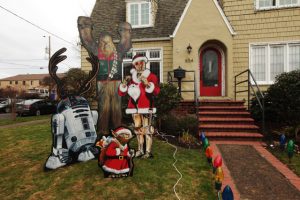
Peacock Lane is Southeast 40th Avenue between Belmont and Stark, which makes it about four blocks long, but since there are no cross streets on SE 40th between Belmont and Stark, it’s really just a lonnnnnnnnng block.
48 weeks out of the year, there’s nothing particularly remarkable about Peacock Lane. It’s just another street with really pretty houses, walking distance to Belmont, Hawthorne, Laurelhurst Park, Mt. Tabor, and Division.
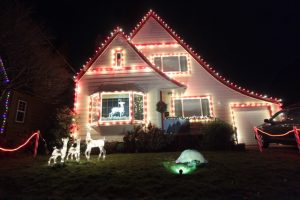
What makes this block special is that the houses on that block go all out with their Christmas decorations. And I mean all out. It’s a tradition that started back to the 1920s and there are a couple of things that make it so very Portland.
In real estate, we deal with Covenants, which are things you’re required to do if you buy a place. And you would think, especially since Peacock Lane is on the US National Register of Historic Places, that there’d be a covenant that makes you decorate your house for Christmas if you live there. But no. People move there because they want to decorate. Nobody tells you that you have to.
 Another thing that makes it totally Portland is that a lot of times, when someone buys a home there, the people selling the home will pass their decorations along to the new buyers. But like I said, one of the things that makes it so very not like Portland is holy crap, it’s crowded! At least for the second half of December. The cops block off the street to car traffic now, which I guess makes it even more Portland. If you live on Peacock Lane and you have an emergency at 5:30 on a December evening –– like you’ve run out of kombucha or something –– you’re sure as heck not getting in your car to get more. I mean, not like you have to. There’s a Walgreen’s right down at the end of the block where, yes, last time I checked they sell kombucha. There’s also a weed dispensary around the corner which used to be this place called Immortal Piano –– broke my heart when it closed because, with a name like Immortal Piano…
Another thing that makes it totally Portland is that a lot of times, when someone buys a home there, the people selling the home will pass their decorations along to the new buyers. But like I said, one of the things that makes it so very not like Portland is holy crap, it’s crowded! At least for the second half of December. The cops block off the street to car traffic now, which I guess makes it even more Portland. If you live on Peacock Lane and you have an emergency at 5:30 on a December evening –– like you’ve run out of kombucha or something –– you’re sure as heck not getting in your car to get more. I mean, not like you have to. There’s a Walgreen’s right down at the end of the block where, yes, last time I checked they sell kombucha. There’s also a weed dispensary around the corner which used to be this place called Immortal Piano –– broke my heart when it closed because, with a name like Immortal Piano…

If it’s a cocktail emergency, you’re staggering distance from several good spots, including the Aalto Lounge, where their happy hour is the stuff of legend. From 5:00 to 7:00 you can get a grilled cheese sandwich and a cup of tomato soup for $3! On the way there, you’ll pass a Stumptown Coffee and a Tao of Tea, so pretty much, it’s a neighborhood with everything.
Best of all is Movie Madness, the neighborhood video store. And yes, there’s still a neighborhood with a neighborhood video store, but calling Movie Madness a video store is like calling the Louvre a building with some nice paintings inside.
Movie Madness has a more extensive collection of arcane cinema than any of the places I used to frequent when I was working as a director in New York or LA. They break things down not just by genre and director, but also country and style. You want to binge French caper films from the 1970s? They can totally hook you up.
 So I know what you’re thinking. You’re thinking, “Well, Brian, that’s all super interesting. Do houses on Peacock Lane cost more than equivalent houses a block or so away?”
So I know what you’re thinking. You’re thinking, “Well, Brian, that’s all super interesting. Do houses on Peacock Lane cost more than equivalent houses a block or so away?”
Great question.
It’s a tough comparison to make because in the past three years, only four houses on Peacock Lane were sold. Those sales took six times as long to close, but the houses went for about 15% more per square foot than houses in the immediately surrounding area.
What that says to me is that Peacock Lane is a neighborhood for a special kind of person. But that person is willing to pay more in order to get to live there.
Got any other real estate (or film) questions? I’m at 310-854-2458.
Portland Neighborhoods: Foster/Powell

You know me. I love pizza. So it should come as no surprise that I love Foster-Powell.
I mean, just look at it on a map. It looks like a slice of pizza!
Yeah. I know. Tenuous. But check this out! Two of the finest pizzerias in all of Portland are in the neighborhood –Char and Pizzeria Otto (which just opened its second location at SE 72nd and Foster). Char is awesome not just because the pizza is amazeballs, but also because the people are super nice and they name the pizzas on the menu after their cats. How Portland is that? And Otto is awesome because the pizzas are wood-fired deliciousness! It’s going to be fun to see these two duke it out.
(I should probably also mention Assembly Brewing, where they make a damn fine pizza in the Detroit style. The only reason I didn’t put it up there with those other two is because honestly, I’ve only had Detroit style pizza at Assembly Brewing and who knows? Maybe you people who actually know what a Detroit pizza is supposed to taste like would consider it an abomination.)
Two — maybe three —awesome pizzerias would make a neighborhood special in just about any other city that’s not in Italy. Let’s be honest, in Portland, it’s barely notable. Portland has more amazing pizza places than anywhere I’ve ever been.
So let’s forget about pizza. Let’s talk about what makes FoPo special.

FoPo is unusual in a Portland neighborhood way in that there’s no central village. It’s bordered on the south by SE Foster and on the north by sE Powell. You’re super smart so you probably already figured out that that’s how it got its name. The border on the east is SE 82nd, or as I like to think of it, The Crust, because let’s be honest, that’s kind what it is.
They keep trying to turn SE 82nd into something it isn’t, meaning to draw your attention away from the auto parts stores and motels and to get you to notice the …um …what? Carpet stores and fast food chains?
The most recent effort was to rebrand SE 82nd as The Jade District, which sort of makes sense. There’s a disproportionate number of Asian businesses on 82nd, places where you can get fantastic dim sum, pho, bahn mi, even groceries they don’t carry at Freddy’s or Safeway. In amongst them you’ll find a fish market, hispanic restaurants, fast food places, and other stuff. But it’s a busy street — a highway, even — so it gets no charm points like Woodstock or Gladstone.
Foster and Powell are slightly less busy than 82nd, but they’re still busy thoroughfares, which make FoPo kind of an island in a swirling sea of commuters. And appropriate to its island-in-the-swirling-sea metaphor, it just might be the best place in Portland to buy fish and seafood. You can get better live lobster cheaper at the no-frills Asian seafood places on Powell than at the fancy-schmancy grocery stores. And unlike the fish markets where they splay dead fish on ice, how awesome is it to make eye contact with your dinner as it swims around in its tank?

On the other hand, at the very tip of the pizza slice, where Foster and Powell intersect, is a Burger King. That feels meaningful, somehow.
There’s a strip of Foster that’s starting to develop a cool vibe, between SE 60th and SE 72nd. You’ve got a tango hall (not making this up — this is Portland) the requisite tattoo parlor, a vegan burger place, a neighborhood grocery, a bagel place where they actually boil their bagels the old fashioned way, and some neat bars.
That having been said, there’s an “elegant” furniture store that I swear, I’ve driven by at least once a day for years and I’ve never seen a single person come in our out, plus no shortage of strip clubs, plumbing supply stores, pot dispensaries, places to buy granite countertops, and body shops. You can even buy gravel and mulch by the truckload and satisfy all your taxidermy needs almost right across the street from a gun shop.
So %$#*! Portland, right?
The neighborhood is unusual in another way. It’s mostly houses. You’d be hard pressed to find a fancy-schmancy condo development in Foster Powell and that gives the neighborhood (or let the neighborhood retain a cozy, family-oriented vibe.

Of course, there are families and there are families. The houses in that pizza slice-shaped triangle are kind of cottage-y. They were built for the most part in the 1920’s. 1930’s, and 1940’s as housing for lower middle class workers. Compared to the classic Portland four-squares that dominate (or used to dominate), say, Clinton and Division, here you’ll find houses that are smaller and less photogenic.

I happen to think that’s a good thing. Sticking with that island thing I set up way back in the 10th paragraph, the houses here are like Mary Ann to Gilligan’s Ginger, if you’re old enough to get that reference. They’re pretty, approachable, sensible homes and as a result, the families that make up the population have a tendency to feel kind of the same. Well, I don’t know about pretty. But definitely approachable and sensible. In a city famous for not showing off, foster Powell makes other neighborhoods look like they’re elbowing each other out to hop the spotlight.
What’s ironic is that FoPo has become kind of a darling of Portland real estate. The recently discovered undiscovered gem, so home prices there have gone up a lot and people are moving in because it’s the place to be a little more than because it’s the place they want to be. According to The Portland Business Journal, the median home price is not $399,000 and what’s even more impressive, the average home sold in the past year was on the market for 12 days.
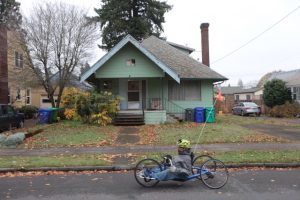 As I mentioned in another post, in Portland we have 20 blocks to a mile so even if you’re out by 82nd, you’re within biking distance of downtown. And it’s a nice ride, too, through Clinton, Ladd’s Addition, and over the Hawthorne bride. You can’t even get lost. Just follow the thousands of other bike commuters making the same trip. It’s a good ride back home. Short enough to do it every day. Strenuous enough that you can justify …you know where I’m going with this …
As I mentioned in another post, in Portland we have 20 blocks to a mile so even if you’re out by 82nd, you’re within biking distance of downtown. And it’s a nice ride, too, through Clinton, Ladd’s Addition, and over the Hawthorne bride. You can’t even get lost. Just follow the thousands of other bike commuters making the same trip. It’s a good ride back home. Short enough to do it every day. Strenuous enough that you can justify …you know where I’m going with this …
Pizza.
41st Annual Duniway Holiday Home Tour
The Duniway Holiday Home Tour and Artisan Boutique is back for the 41st year as Portland’s longest-running house-hopping extravaganza.
The one-day event is Friday, December 6, starting at Duniway Elementary school, 7700 SE Reed College Place, Portland.
All proceeds from the event will benefit the students of Duniway Elementary by providing an arts program, cultural development and other academic enrichments.
The Duniway PTA and gracious members of the community offer 6 outstanding homes to explore. All homes are special and certain to spark nostalgia, inspiration and warm holiday spirit.
This year’s tour features a Mediterranean-style home brimming with an astounding collection of Pop Art and expertly curated Native American art. Other homes include an eclectic vintage-inspired Colonial, and a newly remodeled estate. The six homes offer a diverse array of architecture, landscaping and design: from classic to eclectic, and all the gorgeous styles between.
Nothing enhances a home tour like shopping! The Duniway Artisan Boutique is set to provide all your gift-giving needs. Browse dozens of local vendors in the Duniway Elementary gymnasium for locally made crafts, home goods and treats. Purchase a unique bag or tote made from repurposed material and fill it with handcrafted jewelry, Oregon honey, handmade pasta and soap. Other vendors offer home goods such as special holiday ornaments and eco-friendly laundry products.
From the school, participants can board the complimentary trolley to any of the gorgeous Eastmoreland homes whose residents have opened their doors to benefit Arts education. The trolley circulates on a loop for participants to house-hop at their leisure. A collectible brochure provides a brief description of homes on the tour, and homes can be explored in any chosen order.
The annual event offers two sessions throughout the day from 10am-3pm, and 5pm-9pm. Live music will fill the homes during the evening session.
Tickets are $35 at the door, or $30 in advance at www.duniwayhometour.org. Admission to the Artisan Boutique is free, and will be open 9am-7:30pm. Single ticket purchase provides access to the Tour, Trolley and Boutique.
Portland Neighborhoods: NW 23rd Ave.
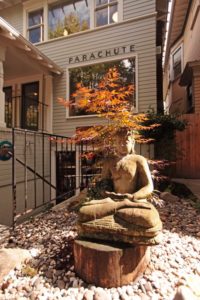


Whenever I work with clients moving to Portland from LA, the first place I take them is NW 23rd. It’s Portland’s version of San Vicente or Larchmont –– a strip of mostly fancy schmancy stores and restaurants that was the main draw back before there were other main draws like Division, Mississippi, Alberta, Lake Oswego, and other neighborhood villages.
 As you can tell from the address, NW 23rd is 23 blocks from the Willamette River, which is just over a mile (blocks in Portland are shorter than they are in a lot of other cities). In between, you have non-stop interesting stuff: NW 21st is kind of the Clinton to 23rd’s Division (see my post on Division here, and on Clinton here). They’re super close, but different enough that people who live there tend to identify with one or the other.
As you can tell from the address, NW 23rd is 23 blocks from the Willamette River, which is just over a mile (blocks in Portland are shorter than they are in a lot of other cities). In between, you have non-stop interesting stuff: NW 21st is kind of the Clinton to 23rd’s Division (see my post on Division here, and on Clinton here). They’re super close, but different enough that people who live there tend to identify with one or the other.
Then there’s the Alphabet District, where you can’t get lost because the avenues are numbered and the streets are alphabetical. (Cool Portland fact: the streets are named after city founders. Other cool Portland fact: If you watch or watched The Simpsons, a lot of those names will look familiar. Matt Groening is from Portland.)

Where was I? Oh yeah. Interesting stuff between NW 23rd and the river. After the Alphabet District, you have Slabtown, the Pearl District, Chinatown, and Old Town. I’ll be writing posts on each of these sections down the road.
Right around NW 23rd, you’ll find a lot of condos, but head west a bit and you get into houses. Amazing old houses, built mostly in the early 1900s.

The street is kind of ideally located. The Portland Streetcar moseys through, connecting the neighborhood to the rest of the city. But it’s actually walking distance to downtown in one direction, the Pearl District in sort-of another, and Forest Park in the another.
NW 23rd used to be distinctive in that it was the only cosmopolitan area of the city. It has a Pottery Barn, Restoration Hardware, Lush, Gap, Ben & Jerry’s, and some other big name stores. “Real” Portlanders like to cop an attitude about that because the city likes to defiantly support local businesses, but with Salt and Straw, Blue Star Donuts, Stumptown, Ace Hotels, and a lot of other local businesses going national and even International, it’s harder to draw the distinction anymore.
And other neighborhoods of the city have let some of those big name national brands leak in.

But there are some things along NW 23rd that you can’t find elsewhere in Portland. One is St. Jack, a French Bistro where they make two things that are worth the hike all the way from my house: the chicken liver mousse which is, I’m serious, a $%&*!! revelation and a drink called The French Pearl that I swear tastes like sipping springtime. Another is Kornblatt’s Deli, the only (unless you count newcomer Kenny and Zuke’s) Jewish deli in Portland.
Just off NW 23rd at the north end you have St. Honore, a bakery that looks like something out of an old French movie and Kenny and Zuke’s Bagelworks, where the bagels are actually good. Really good. Better than most of the bagels I had when I lived in New York good.

Oh, and this is cool! Every September, the Vaux’s Swifts stop off on their annual migration to spend the night in a chimney at Chapman Elementary School (1445 NW 26th Ave). Head over there any day of the month just before dusk and join thousands of Portlanders who think sitting on a blanket on the grass and watching birds fly into a chimney is more exciting than any Miley Cyrus concert.
I’ll be there. Look for me. Afterward, we can head over to St. Jack.
Let’s Get Fancy – Inhabit’s Fall 2019 Newsletter
It’s that time of year when everything changes and Inhabit’s fall newsletter is all about elevating your everyday experiences. You’ll find it here!
Portland Neighborhoods: Clinton
Remember Manhattan back in the 40’s and 50’s, when you could walk a block and go from one neighborhood to another one that was totally distinct?
Me neither.
But I’ve heard stories. And when I used to live there, you could still find vestiges – little reminders that the German neighborhood you were in butted right up against the Italian neighborhood a couple of streets over.


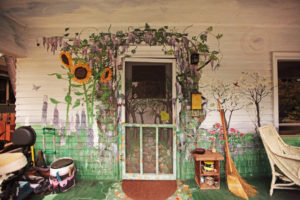
Portland has a lot of that. More subtle than in New York, but places where there’s a real difference in the personalities between two areas. Colonial Heights is different from Ladd’s Addition. NW 21st is different from NW 23rd. Hawthorne is different from Belmont, which is different from Stark, which is different from Burnside. And Clinton is different from Division.

 I’ve already gone on about Division (click here to reread my extremely informative and even vaguely accurate post), but to recap: 1) Freeway, 2) no freeway, 3) hippies, 4) fancy restaurants, 5) hipsters.
I’ve already gone on about Division (click here to reread my extremely informative and even vaguely accurate post), but to recap: 1) Freeway, 2) no freeway, 3) hippies, 4) fancy restaurants, 5) hipsters.
Clinton is a block away, but where Division was originally kind of an industrial cut through, Clinton began life totally residential. So even though the same hippies bought houses in both Clinton and Division for pennies on the dollar when the government abandoned its plan to build a freeway into downtown, neighborhood stuff got (and gets) emphasized on Clinton a lot more. To the point that today, cars get to drive on division; bikes own Clinton.

Clinton is what the city calls a Designated Bike Boulevard, which is defined as “low-volume and low-speed streets that have been optimized for bicycle travel through treatments such as traffic calming and traffic reduction, signage and pavement markings, and intersection crossing treatment.” Clinton has speed bumps, signs, DUI catchers (little roundabouts in intersections), even special street signs with cute little bikes on top – all that and more. In fact, just try to drive a car down the street. You can’t. There are spot where cars are actually forced to turn off.
When old homes are torn down in Clinton, they’re usually replaced by new homes. On Division – and did I mention that Division is seriously only a block away? – when old homes get torn down they’re usually replaced by multi unit housing.

Like most of the neighborhoods in Portland, Clinton is its own little village. In and just off of the stretch between SE 20th and SE 26th you’ve got your pizza place (Hammy’s), a breakfast place (Off the Waffle), a diner (Dots, which is surprisingly good), an artsy brasserie (La Moule), another artsy brasserie (Jacqueline), and a kajillion other places to eat and drink and watch the parade of bike commuters on their way to and from work. There’s a fancy grocery store (New Seasons, which is really on Division, but like I said, a block away, and actually more connected to Clinton), and a food co-op (People’s Food Co-Op on SE 21st and Tibbetts).
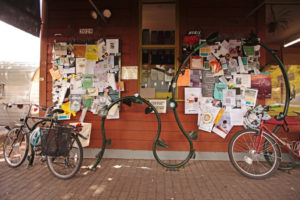 You also have two optometrists, a boutique that sells kid stuff …even two real estate offices.
You also have two optometrists, a boutique that sells kid stuff …even two real estate offices.
Which you really don’t need to bother with. I mean, you have me, right?
For a complete Portland bike map, click here.
Portland Neighborhoods: Mt. Scott Park*
*not to be confused with Mt. Scott, a 1,091-foot-high volcanic cinder cone in Clackamas County
When I first moved to Portland 13 years ago, I was told to stay away from this area. People called it Felony Flats. A lot of the yards had pit bulls chained up in them, next to the carcasses of dead cars and appliances.
Oh how things change.

It’s still one of the more affordable neighborhoods in the city, but according to Portland Monthly the median home price is now $384,999. Felony Estates, more like.
It’s the area between SE 52nd and SE 82nd, north of Woodstock and south of Foster. (Cool fact: Foster Road was named for Philip Foster, who owned a trading post near Estacada in the late 1800s and was married to Mary Charlotte Pettygrove. Another cool fact: Foster Road was built on top of the northern fork of the Oregon Trail.)

The centerpiece of the Mt. Scott Park neighborhood is …wait for it …Mt. Scott Park. It’s a quiet, family-friendly park, and just about every weekend there’s a birthday or graduation or something being celebrated in one of the picnic areas. A couple of years ago, the World Naked Bike Ride started in the park. So yeah, totally wholesome.
 Okay, I lied. The Mt. Scott community Center is the centerpiece of the neighborhood. It’s adjacent to or maybe in the park and has two swimming pools – one that’s great for lap swimming and water aerobics and the other that’s built just for kids, with a slide, whirlpool, buckets that splash water on top of you, and a wading area that graaaaaaaadually gets deeper and deeper until the water comes all the way up to your knee.
Okay, I lied. The Mt. Scott community Center is the centerpiece of the neighborhood. It’s adjacent to or maybe in the park and has two swimming pools – one that’s great for lap swimming and water aerobics and the other that’s built just for kids, with a slide, whirlpool, buckets that splash water on top of you, and a wading area that graaaaaaaadually gets deeper and deeper until the water comes all the way up to your knee.

The neighborhood is culturally diverse with a pretty substantial Russian population, as well as Mexican and Vietnamese.
In addition to the pools, the community center has a basketball court, a gym, meeting rooms, and a skating rink. For real. A skating rink with wood floors and posts which I know from first-hand experience are placed perfectly for you to run into when you’re trying to teach your kid how to skate and not paying close attention to where you’re going.
Someone told me that in the old days, the Mt. Scott Trolley ran from downtown Portland up to the town of Lents and no, I have no idea why it was called the Mt. Scott Trolley, but because that was the name of the line, that became the name of the park.
 I was also told that the Arleta Triangle, a weird orphan of land that’s cut off from the southwest corner of the park at SE 72nd and Woodstock, came about because trolley tracks were laid to cut the corner of the park, leaving a little triangle of land all sad and lonely out there in the middle of the intersection. It sounds convincing, but according to the 1942 trolley route map I dug up, the trolley didn’t go anywhere near that corner. And also, it wasn’t called the Mt. Scott Trolley.
I was also told that the Arleta Triangle, a weird orphan of land that’s cut off from the southwest corner of the park at SE 72nd and Woodstock, came about because trolley tracks were laid to cut the corner of the park, leaving a little triangle of land all sad and lonely out there in the middle of the intersection. It sounds convincing, but according to the 1942 trolley route map I dug up, the trolley didn’t go anywhere near that corner. And also, it wasn’t called the Mt. Scott Trolley.
Anyway.
Speaking of things that are named for what they aren’t, across the street form the park is the Arleta Library, which isn’t a library, but a breakfast place that got famous because some TV Chefs ate there once. It’s good, but good enough to wait in line to get in? Yeah, actually it is.
Next door to the Arleta Library is Space Monkey Coffee where I have a secret crush on a barista named Amy. If you go there, tell her hi for me.
Okay, I lied. The centerpiece of the neighborhood is the Portland Mercado at SE 72nd and Foster. It’s a collection of Hispanic food cars – everything from Colombian to Peruvian to Oaxacan to Cuban – plus a tiendita for groceries, a carniceria for meats, a cafeteria for coffee, and a bar.

You know what? For real, the centerpiece of the neighborhood is Milo, the Best Puppy Ever™. He lives across the street from the park and loves to invite neighborhood dogs into his yard for play dates. If he’s not out by the gate when you come by, ring his doorbell on the little free library and he’ll come out. Unless he’s gone to work with his dad (me) to sell some houses in the neighborhood.
– Brian
Portland Neighborhoods: Division
(Not the definitive history, but my version, which includes maybe a little hearsay, a little mythology)
Something like 45 years ago, the federal government decided to put a freeway into Portland and bought up a swath of old houses along the proposed route –– SE Division Street. Scrappy Portland citizens said “we don’t want your stinkin’ freeway” and managed to force the project to be abandoned, which left the government holding a ton of properties. The government decided to get rid of the properties and because governments are so good at turning a profit, they sold the houses for pennies on the dollar.
 The timing was perfect for hippies. San Francisco was getting pricey. So tons of them hitchhiked up north to a land where you could drive a VW bus 20 minutes in almost any direction and find yourself in a gloriously beautiful setting –– you could take a quick hike through misty woods, pluck a couple of psychedelic mushrooms, and bliss out naked in a hot spring.
The timing was perfect for hippies. San Francisco was getting pricey. So tons of them hitchhiked up north to a land where you could drive a VW bus 20 minutes in almost any direction and find yourself in a gloriously beautiful setting –– you could take a quick hike through misty woods, pluck a couple of psychedelic mushrooms, and bliss out naked in a hot spring.
Up until that point, Portland was a rough, blue-collar manufacturing and timber town. But so many hippies invaded that the city’s personality changed.
 The hippies turned their craftsman houses into goat barns, pottery studios, rooming houses, and mini ashrams. They didn’t have the money (or inclination) to tear the houses down and build modern houses, but they put enough love and care into them to keep them from falling completely apart.
The hippies turned their craftsman houses into goat barns, pottery studios, rooming houses, and mini ashrams. They didn’t have the money (or inclination) to tear the houses down and build modern houses, but they put enough love and care into them to keep them from falling completely apart.
35 years later, the rest of the country discovered this little time warp and what it had become. Disaffected young people from all over the US started moving into the city in hopes that they, too, could live a life where a kombucha culture got more attention than a time sheet.
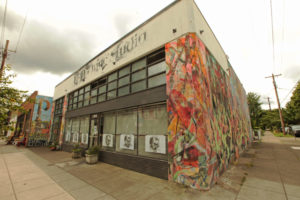 About 15 years ago, I can’t remember who, but some adventurous chef decided to open a restaurant on SE Division, driven mostly by how inexpensive the property was. The restaurant became a media darling and other chefs came in with their restaurants. Soon Division became a culinary destination. That’s about the time that I moved into the neighborhood. I used to walk five blocks to Pok Pok, sit down, and have a great lunch. Now you have to wait in line for an hour to get in.
About 15 years ago, I can’t remember who, but some adventurous chef decided to open a restaurant on SE Division, driven mostly by how inexpensive the property was. The restaurant became a media darling and other chefs came in with their restaurants. Soon Division became a culinary destination. That’s about the time that I moved into the neighborhood. I used to walk five blocks to Pok Pok, sit down, and have a great lunch. Now you have to wait in line for an hour to get in.
I remember when the first condos went up in the neighborhood and the developer priced the units at the audaciously exorbitant price of $225,000 a unit. I bet he’s kicking himself now. I know I am.
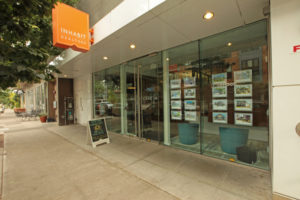
Division these days is one culinary experience after another, with pricey little boutiques interspersed in between. But a lot of the original residents are still there. They like to complain about having to pay $4 for a cup of coffee and about how they have to park sometimes a block away from their houses, but their homes are worth $750,000 and up.
Division street itself is becoming a canyon of condos, which is hard to square with its original vibe. Many of the restaurants there are now mini-chains. The Bollywood Theater is a wonderful example of a really neat restaurant that was established in another neighborhood, but has a branch on Division. Those of us who have lived here long enough feel like that’s some kind of betrayal, but let’s be honest, the food is good and they only have two locations. That doesn’t make them The Great Satan.
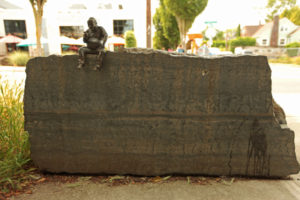 Division is super close to downtown. You just hop on your bike and pedal thirty some-odd blocks and you’re at the river. Take the Hawthorne Bridge across and bam, you’re there. Bonus, Hawthorne is about a half mile to the north and Clinton is two blocks south and a little west. Getting to the airport is pretty easy, too. Just head east to the 205 Freeway and go north. It used to take me 20 minutes. I suppose now it’s 35 when there’s traffic.
Division is super close to downtown. You just hop on your bike and pedal thirty some-odd blocks and you’re at the river. Take the Hawthorne Bridge across and bam, you’re there. Bonus, Hawthorne is about a half mile to the north and Clinton is two blocks south and a little west. Getting to the airport is pretty easy, too. Just head east to the 205 Freeway and go north. It used to take me 20 minutes. I suppose now it’s 35 when there’s traffic.
Some of my favorite places on Division:
- Scottie’s Pizza (One of the best pizza places in the city. And that’s saying a lot. Portland has tons of great pizza places.)
- Bollywood Theater
- Pok Pok
- Lauretta Jeans (Amazing pie. I take my kids there for Pi Day every March 14th and the place is packed with math geeks.)
- Pinolo Gelato (Just a couple blocks from Salt & Straw. I like it better.)
- Cibo (*&$%!! good happy hour, with another amazing pizza.)
Inhabit is Featured in Real Producers Magazine
It was super fun to be interviewed and photographed by Portland Real Producers Magazine. Check out the link to the full article below to find out what they asked us!
It’s Time for a Fresh Start – Inhabit’s Spring 2019 Newsletter
Inhabit’s spring newsletter is all about mixing things up and starting fresh. You’ll find it here!
Celebrating 5 Years Inhabiting our Flagship Office in SE Portland
Celebrating 5 Years Inhabiting our Flagship Office in SE Portland
5 years ago, Inhabit Real Estate decided to put down stakes on SE Division Street at the epicenter of it all. It was during a time that the neighborhood was experiencing tremendous growth and the landscape of the street was transforming a little too rapidly for some. A sea of mixed-use, 4-story apartment buildings sprung up between existing shops and restaurants. The renewed energy brought in some anchor tenants that literally transformed the entire neighborhood vibe. Today, it’s an area that literally buzzes with energy. The street is lined with noteworthy eateries and was dubbed one of the “10 Best Foodie Streets in America” by Food and Wine Magazine. The restaurants, unique shopping, and local vibe make it a worthy destination in Portland. We happily claim our spot nestled between the Whiskey Soda Lounge and Bula Kava House at 31st and Division.
 As a small, Portland-based company, our goal was to celebrate everything local in our design. We partnered with Maven Interiors, an award-winning local design company and Christopher McDonald (our good friend and amazing carpenter/ contractor) to do the build-out. We challenged the design team to create something that was unique, sustainable and had a hand-crafted feel. We wanted our storefront to add to the streetscape and our presence embraced by the community.
As a small, Portland-based company, our goal was to celebrate everything local in our design. We partnered with Maven Interiors, an award-winning local design company and Christopher McDonald (our good friend and amazing carpenter/ contractor) to do the build-out. We challenged the design team to create something that was unique, sustainable and had a hand-crafted feel. We wanted our storefront to add to the streetscape and our presence embraced by the community.
Here’s a brief tour of some of the “local” aspects of our office…
One of the first things you will notice as soon as you walk in the office is a huge mural of an abstract Portland map that we commissioned local artist Jerry Inscoe to create for us. The red peg indicates “you are here”.
We looked for opportunities to infuse art in unexpected ways. Our interior doors, for example, became blank canvases. We asked Jerry Inscoe to collaborate with local artist Jennifer Mercede to bring our doors to life in an otherwise uninspired corridor. Jerry airbrushed abstract backgrounds and Jennifer painted things reminiscent of Portland (Doug firs, bubbler fountains, bicycles, etc) in a whimsical doodle fashion on top. The contrasting styles of the artists resulted in one-of-a-kind creations.
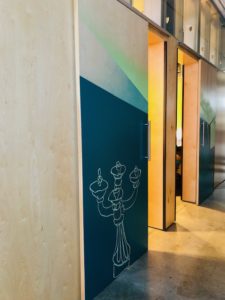

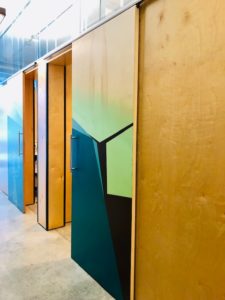
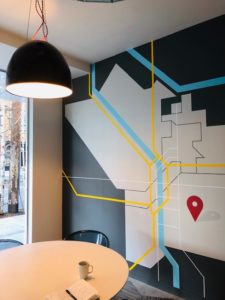 We turned to Portland’s own Schoolhouse Electric for all of our office pendants lights and Pratt and Larson Tile for our handmade kitchen backsplash.
We turned to Portland’s own Schoolhouse Electric for all of our office pendants lights and Pratt and Larson Tile for our handmade kitchen backsplash.
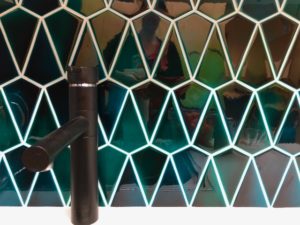

The bathroom wallpaper is the work of local designers at MAKELIKE, a graphic design collective in SE Portland. We loved continuing the unexpected whimsy in the loo.
All of our office partitions and workstations were custom designed by Maven Interiors and hand built by Chris McDonald. The materials used are untraditional, just like us. We are different by design.



The next time you find yourself on SE Division Street, please stop by for a tour and a cup of coffee. We would be happy to make your acquaintance.
Why 2019 Could be a Great Year to Sell Your Home
With the Feds increasing interest rates already 3 times the last 12 months (and a possible 4th predicted); it’s understandable that people could be hesitant to make any real estate moves. Mortgage rates tend to mirror interest rates, but with some caveats. Mortgage rates are based on the current market, your financial status and the property you are trying to purchase. Mortgage rates hit a 7-year high in November, 2018 at just under 5% as reported by Freddy Mac, but as of February the rates have lowered to the mid to low 4% range. These rates are still incredible if you consider the historic high of 18% in 1981.
Housing markets and volatility will vary depending on where you live. Thankfully, Portland is still a growing and sought after destination which helps keep our market volatility more steady. So why would selling in 2019 be better than 2020 or 2021? Our housing market has a cycle of its own that is influenced by the economy. Typically the cycle is somewhere between 10-16 years. Some experts are predicting the next recession happening in 2020 or 2021. That prediction would be in line with our typical cycle length since the last housing “crash” was in 2008.
If you are unsure what to do, here are some compelling things to think about…
Reasons to Sell in 2019:

- Do you have plans to make a move in the next 3 years?
- Do you have considerable equity in your home? The higher your down payment on a new home, the better your interest rate.
- Interest rates are predicted to rise again in the next year
- New home buyers are entering the market. Based on a recent Trulia survey, millennials are the largest buying group with 1 out of 5 reporting they will buy a home in the next 12 months.
- If you are getting close to retirement and the equity in your home is a big part of your financial picture, then waiting out the next economic cycle might not be the best plan.
Reasons not to Sell in 2019:
- You haven’t owned your current home for long enough to build up enough equity. If you’ve owned for less than 2 years, then paying capital gains on your profit is a deterrent as well.
- You are happy with your home and believe it can meet your needs for the next 5 years or more, then staying put and waiting until the next cycle is probably in your best interest.
I created Inhabit to be a trusted resource for guiding people on how to get the most out of their largest and most important asset. Our overarching goal is to be a trusted advisor and build relationships that withstand all the market ups and downs.
If you want help assessing what you should do to get the most out of your real estate investment, I’m just a phone call away.
Look on the Bright Side – Inhabit’s Winter 2019 Newsletter
Inhabit’s winter newsletter is chock-full of suggestions to brighten, lighten, and enliven Portland’s dark, wet season. Find it here!
Oregon Tenant Protection Bill
This seems to be a subject much talked about amongst real estate agents, property managers, landlords, tenants, and homeowners (i.e. everyone). Yet, if you Google “Oregon tenant protection bill” or “Portland tenant rights bill”, all you’ll get is a few cut and dry articles from the Oregonian and other local news blogs and not much else. Most of what you’ll see will be about other legislation that has already passed.
What are we afraid to talk about? I’m a Portland area real estate agent and I eat complicated, controversial topics for breakfast. Okay, no, I usually eat eggs for breakfast. Sometimes cereal. Occasionally a snack bar…
But that’s beside the point. Let’s boldly go where few have gone before.
The original version of this article can be found here.
 Boldly blogging where no one has blogged before.
Boldly blogging where no one has blogged before.
The housing shortage is driving legislation.
People are passionate about this subject because Portland is in a housing shortage. We need approximately 24,000 units to meet demand (read my blog about all the people moving here). Barring economic catastrophe, a housing shortage will always cause home values to rise and rents to increase. This places undo pressure on tenants and home buyers, while current homeowners get to watch their net worth rise and landlords have the opportunity to raise rents.
The only real solution to a housing shortage is to build more housing but of course we only have so much space available. But, hey, we’re Portlanders, and if we can find a weird way to help solve this problem, by golly, we’re gonna leap down that rabbit hole.
Multnomah County and Enhabit (no relation to Inhabit) are launching a pilot project called “A Place For You”. It aims to build ADUs (accessory dwelling units or “tiny homes”) in Portland resident’s backyards. These will be used to house homeless families rent-free for 5 years in exchange for a tax abatement to the property owner. After 5 years, the homeowner gets to keep the ADU to be used as they see fit. The pilot project is starting with just 4 units but over a 1,000 homeowners have expressed interest.
It almost sounds like an episode of Portlandia.
 It’s okay if you don’t know what this is. What am I saying? No, it’s not okay. It will never be okay. Things will never be the same again!
It’s okay if you don’t know what this is. What am I saying? No, it’s not okay. It will never be okay. Things will never be the same again!
This is an interesting idea but creativity isn’t going to get us very far in the short term (and that doesn’t get politicians re-elected). The housing shortage is enough of a hot topic that politicians such as Ted Wheeler and Tina Kotek have thrown their weight toward repealing the statewide ban on rent control (although last year Ted Wheeler said he supported this for the state but not in Portland, where he would adopt other measures first, he seems to have now changed his position). In the election last year, Chloe Eudaly upset incumbent Commissioner Steve Novick despite having no political experience. Her grassroots campaign for the Portland City Council was focused entirely on tenants rights.
Now that we’re firmly into 2017 it means that politicians are putting their legislation where their mouth is.
In Portland, new rental ordinance is already in place.
Before we talk about the infamous House Bill 2004, let’s quickly take a look at the tenant protection ordinance that took effect back in February this year. This was an emergency ordinance brought forward by Chloe Eudaly and Ted Wheeler that was passed unanimously by the Portland City Council. It requires landlords to pay moving costs for tenants that are evicted without cause or for tenants that must move because rents have been increased by more than 10 percent in a 12 month period. The one exemption is for landlords that have only one rental unit. Moving costs paid by the landlord range from $2900 to $4500 depending on number of bedrooms.
Attorneys are already dueling in court over the legality of this ordinance but for now it stands.
 Not that kind of duel. Although court cases might be more interesting this way.
Not that kind of duel. Although court cases might be more interesting this way.
This brings us to the Tenant Protection Bill (HB 2004) that was recently passed (31 in favor – 27 opposed) by the Oregon House of Representatives and has now moved along to the state Senate for review. There are a lot of nuances to this bill and several compromises were made to get it this far. Remember, this is NOT law yet.
Here’s a few salient points of the pending bill.
- After 6 months, no-cause eviction of tenants renting month-to-month are banned (before 6 months no-cause eviction of tenants renting month-to-month are allowed with 30 days written notice).
- After 6 months, evictions are allowed for month-to-month (30 days after the effective date of this legislation) and fixed term tenants (immediately after the effective date) with 90 days written notice for specified reasons, such as renovations, repairs, when the property is scheduled to be demolished, or for the sale of the property. Landlords must pay one months rent to cover relocation expenses in this case. (However, if the reason is repairs/renovations, the landlord must offer a new rental agreement back to the evicted tenant before other potential tenants.)
- After 6 months, evictions are allowed for month-to-month and fixed term tenants with 30 days written notice for cause. (Examples of cause: non-payment of rent, violation of drug or alcohol program, pet violation, substantial damage, etc. There are additional provisions that govern “cause” and timelines that a landlord should be fully aware of.)
- If the landlord terminates the tenancy in violation of the provisions, the landlord would be required to pay 3 months of rent to the tenant in addition to potential damages. This applies to both month-to-month (30 days after the effective date) and fixed tenancies (immediately after the effective date).
- Exceptions to the above exist for landlords that own four or fewer rental units or for landlords that live on the property and own two or fewer rental units.
- The bill also allows cities and counties to adopt their own rent control program which effectively abolishes the statewide ban on rent control.
- An exemption to rent control is provided for any new residential development for a period of 5 years from the date of issuance of the first certificate of occupancy.
- If a city or county passes a rent “stabilization” program, it must provide landlords with a fair rate of return and a process for the the landlord to petition for permission to increase rent in excess of the amount allowed in the program when needed to achieve a fair rate of return.
 The rubics cube of government. Nuff said.
The rubics cube of government. Nuff said.
A few of the compromises that allowed this bill to pass include the exemption for landlords that own 4 or fewer units, reducing mandatory relocation assistance down to one month (originally the bill called for three months even when the eviction is for an allowed reason), and the 5 year exemption for new residential developments.
What does this mean?
So, does this bill seem sensible? Why would anyone object to it? Why was it passed on such a slim margin and why is the battle for it in the senate expected to be difficult?
I think the biggest concern is with point 6 – 8. Rent control is only fiercely debated when you don’t talk to economists. Meaning, economists largely have a consensus of opinion that rent control results in a reduced supply of property to the market (which of course drives rents and home prices even higher).
Wait a second, reduces the supply? Didn’t I just say earlier that this problem is a result of a housing shortage?
Based on historical data, most economists viewpoints, and studies that have been conducted on rent control, enacting rent control (or “stabilization”) causes housing shortages to become worse than if no controlling measures were put into place. I don’t like it when legislatures pass bills with provisions that aren’t supported by the data. (Read this article and this one and this one to gain some perspective on what economists think about rent control)
I don’t think the 5 year exemption for new construction or vague “fair rate of return” language is enough to curb the negative side effects of rent control but politicians only have so many tools in their belt when in comes to housing. Those tools tend to be very blunt instruments. Even though a screwdriver might be needed, we’re instead getting a hammer. Or maybe a mallet. Or maybe even a sledgehammer. Except I don’t think Peter Gabriel is the solution here.
 This analogy is too good for a caption.
This analogy is too good for a caption.
The merits of points 1 through 5 above really come down to your point of view. I won’t delve into those here other than to say that I see both the positive and negative ramifications to being this restrictive about evictions but I’m open minded about the ideas.
HB 2004 hasn’t passed the senate yet (it was just referred to the Human Services committee). I’ll be following along to see if it passes and is signed by the governor, or if it dies, or if it becomes reborn as something more palatable. This is an interesting time for anyone that is a landlord or tenant!
Do you own a rental property? If so, what are your plans? If this bill passes, much of the legislation will go into effect either immediately or within 30 days. I’m a Portland area realtor and can assist you in deciding what course of action makes sense for your investment. Contact me if you have questions.



















